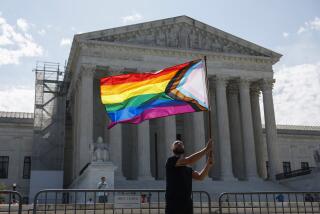Nationwide gay and lesbian population count breaks new ground
- Share via
A new study tracking the percentage of gay and lesbian adults in America has established a first-ever demographic atlas of the group, finding that state populations range from a low of 1.7% of in North Dakota to a high of 10% in the District of Columbia.
The study, conducted by Gallup Poll Editor-in-Chief Frank Newport and UCLA scholar Gary J. Gates is the largest population-based survey to include a state-by-state measurement of lesbian, gay, bisexual and transgender identification.
“This is simply new ground -- these are not just new statistics, they are the only estimates we have of these people at the state level,” Gates, a demographer at the Williams Institute at UCLA, which studies sexual orientation, told the Los Angeles Times. “There is no other data out there to verify these numbers, which constitute a significant advancement in our understanding of the LGBT population.”
In all, more than 206,000 adult Americans were surveyed for the expansive study, with 41 of the 50 states including polling samples that exceeded 1,000, researchers said. Participants responded to the question, “Do you, personally, identify as lesbian, gay, bisexual, or transgender?” in surveys conducted between June 1 and Dec. 30, 2012.
Only eight states had less than 1,000 completed interviews, including the lowest sample size of 613 in Alaska.
Analyzing the state-by-state breakdown, researchers found that while LGBT communities are clearly present nationwide, their visibility is generally higher in states with greater levels of social acceptance and supportive LGBT legal climates.
David Mariner, executive director of the Center for the LGBT Community in Washington, D.C., applauded the study for being done but said it offered few surprises.
“We’ve always known that D.C. has a strong gay and lesbian community but, that said, it’s good to know where these people are on a national basis,” he told the Los Angeles Times. “It’s a good indicator of where people feel comfortable living and where people want to live. Some who grew up in small towns want to stay there but others want to move to places where they feel more welcome.”
Researchers said their results defied stereotypes that portray the LGBT community as heavily grouped in urban centers. With the exception of the District of Columbia, LGBT populations range 3.4 percentage points nationwide, with a low of 1.7% in North Dakota to 5.1% in Hawaii.
With the exception of South Dakota, each state with LGBT populations of 4% and over has laws prohibiting discrimination based on sexual orientation and gender identity. These states have also taken steps toward more LGBT equality by recognizing same-sex marriages, civil unions or domestic partnerships. Six of the 10 states with the lowest LGBT populations are among the most conservative states in the country, researcher found.
California ranked 10th, with 4% of the population identifying as belonging to the LGBT community. On the high end of the scale, Vermont and Oregon tallied 4.9% while Tennessee, Mississippi and Montana each had 2.6%.
Nonwhites are more likely than white segments of the U.S. population to identify as LGBT. The survey results show that 4.6% of African Americans identify as LGBT, along with 4.0% of Latinos and 4.3% of Asians, according to the study.
Researchers acknowledged that measuring the LGBT community has previously been the subject of debate.
“As a group still subject to social stigma, many of those who identify as lesbian, gay, bisexual or transgender may not be forthcoming about this identity when asked about it in a survey,” researchers pointed out in the study. “Therefore, it’s likely that some Americans in what is commonly referred to as ‘the closet’ would not be included in the estimates derived from the Gallup interviews.
Jim Key, a spokesman for the Los Angeles Gay and Lesbian Center, agreed that the study probably underrepresented the number of LGBT people nationwide.
“There are people who don’t identify with any of the letters, L, G, B or T,” he told The Times. “Many are young people who don’t see themselves as gay or lesbian, but simply as people who are in love with someone of the same sex.”
Key said the study did present some possible surprises.
“It might be surprising for people to learn that LGBT people are truly everywhere,” he said. “We have more than 200 different LGBT community centers around the country. It’s not surprising that we are found in every state of the union, but it may open some eyes that gays and lesbians are spread so consistently around America.”
More to Read
Sign up for Essential California
The most important California stories and recommendations in your inbox every morning.
You may occasionally receive promotional content from the Los Angeles Times.










